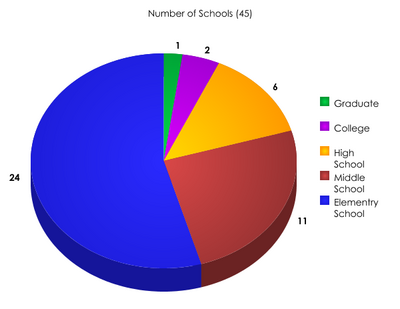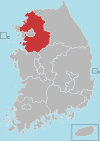world.wikisort.org - South_Korea
Gimpo (Korean pronunciation: [ˈkim.pʰo]) is a city in Gyeonggi Province, South Korea. It borders Incheon, with which it shares the South Korean side of the Han River estuary, as well as Seoul and the lesser cities of Paju and Goyang. North Korea is across the Han River. The current mayor is Jeong Hayoung (정하영). The city's population of more than 300,000[1] is made up of more than 71,000 households.
This article needs additional citations for verification. (July 2020) |
Gimpo
김포시 | |
|---|---|
Municipal City | |
| Korean transcription(s) | |
| • Hangul | 김포시 |
| • Hanja | 金浦市 |
| • Revised Romanization | Gimpo-si |
| • McCune-Reischauer | Kimp'o-si |
 Flag  Emblem of Gimpo | |
| Country | |
| Region | Gyeonggi Province (Sudogwon) |
| Administrative divisions | 3 eup, 3 myeon, 7 dong |
| Area | |
| • Total | 276.6 km2 (106.8 sq mi) |
| Population (2019 Mar) | |
| • Total | 427,754 |
| • Density | 1,546.55/km2 (4,005.5/sq mi) |
| • Dialect | Seoul |
Gimpo International Airport (formerly Kimpo International Airport) used to be located inside the city, but is now part of Seoul. Tertiary educational institutions located in the city include Kimpo College and Joong-ang Seungga University. There are 27 elementary schools, 12 middle schools, and 8 high schools, including Gimpo Foreign Language High School. Three elementary schools, two middle, and two high schools are located in the area of Tongjin.
Modern history
In 1914, Yangcheon county and Gimpo county were merged. Yangcheon county was separated into 2 towns (Yangdong and Yangseo). In 1958, Yeouido international airport was relocated to Gimpo. In 1963, Yangdong and Yangseo towns were incorporated into Yeongdeungpo-gu; it includes Gimpo International Airport. In 1973, Gyeyang and Ojeong towns of Bucheon were transferred to Gimpo. In 1989, parts of Gyeyang town were ceded to Incheon, giving Incheon a border with southwestern Seoul. And 1995, Geomdan region was ceded to Incheon. In 1998, Gimpo was promoted to city. Since the Hangang New Town was announced in 2003, the population of the city has soared. Gimpo Light Rail was opened in 2019 for the sake of population growth and the convenience of transportation in the new Han River city. This line connects Yangchon Station and Gimpo Airport Station, which is a two-car light rail line. In response, some citizens are demanding more cars or extension of Seoul Subway Line No. 5 in preparation for the soaring demand for transportation in the future. The airport at Kimpo (Gimpo) was known as "K-14" Air Force Base during the Korean War. Sabre jets were based and operated from K-14 to "Mig Alley" located in the north western area of North Korea, and where air combat would take place with enemy Mig aircraft. A large number of U.S. Air Force bases were located thru out South Korea during the Korean War, and each of them had a "K" number, again with Kimpo being K-14, and with the "K" meaning Korea.
Statistics

Industry
Regional Gross Domestic Product
Gimpo City's gross domestic product in 2012 was 16.98 trillion won, accounting for 2.2 percent of the total in Gyeonggi Province. Among them, agriculture, forestry, and fisheries (primary industry) account for 248.5 billion won. In contrast, mining and manufacturing (second industry) account for 63.1 percent of the total, while commercial and service industries account for 35.3 percent, or 5.6869 trillion won. In the second industrial sector, wholesale and retail businesses (5.4 percent), construction (4.7 percent), real estate and rental businesses (3.7 percent), and electricity, gas, steam, and water projects (3.0 percent) account for a large portion as the new Gimpo Han River is built.[2]
Status of employees
In 2014, the Gimpo city industry's total number stood at 129,440, accounting for 2.9 percent of the total number of workers in Gyeonggi Province. Among them, agriculture and forestry (primary industry) account for 93 people. In contrast, mining and manufacturing (second industry) account for 48.6 percent of 62,946, while commercial and service industries (third industry) account for 51.3 percent with 66,401. The secondary industry is higher than the overall proportion of Gyeonggi Province (27.1 percent), and the tertiary industry is lower than the overall proportion of Gyeonggi Province (72.9 percent). In the third industrial sector, wholesale and retail (12.1 percent), lodging and restaurant (7.7 percent), education and services (6.2 percent), and health and social welfare (5.2 percent).[2]
Resident Population and Floating Population
As of 2010, Gimpo's city had 215,050 residents and 227,159 weekly population, with the weekly population index high at 106. The number of people inflowing from commuting to work is 45,757. The number of people leaking from school is 31,213, and 2,687 and 5,122 more people flowing from school, a common phenomenon in the outskirts of the Seoul metropolitan area where many industrial facilities have been relocated.[2]
Tourist spots
- Munsu Fortress
- Jangneung
- Deokpojin
- Aegi Peak
- Daemyeong Port
- DMZ Peace Trail
- Czong Institute for Contemporary Art (CICA Museum)
Sister cities
 Glendale, California, United States
Glendale, California, United States Hampyeong, South Jeolla, South Korea
Hampyeong, South Jeolla, South Korea Xinmin, Liaoning, China
Xinmin, Liaoning, China Heze, Shandong, China
Heze, Shandong, China
See also
- List of cities in South Korea
- Geography of South Korea
- Seoul National Capital Area
- Gimpo International Airport
- Gimpo Peninsula
References
- "Gimpo-si (City, Gyeonggi-do, South Korea) - Population Statistics, Charts, Map and Location". www.citypopulation.de. Retrieved 2020-09-28.
- "Gimpo". Full Life Gimpo.
External links
На других языках
- [en] Gimpo
[ru] Кимпхо
Кимпхо́ (кор. 김포시?, 金浦市?, Gimpo-si) — город в провинции Кёнгидо, Южная Корея. На его территории располагается аэропорт Кимпхо, который до 2001 года был главным аэропортом страны, а теперь обслуживает в основном внутренние рейсы.Другой контент может иметь иную лицензию. Перед использованием материалов сайта WikiSort.org внимательно изучите правила лицензирования конкретных элементов наполнения сайта.
WikiSort.org - проект по пересортировке и дополнению контента Википедии
